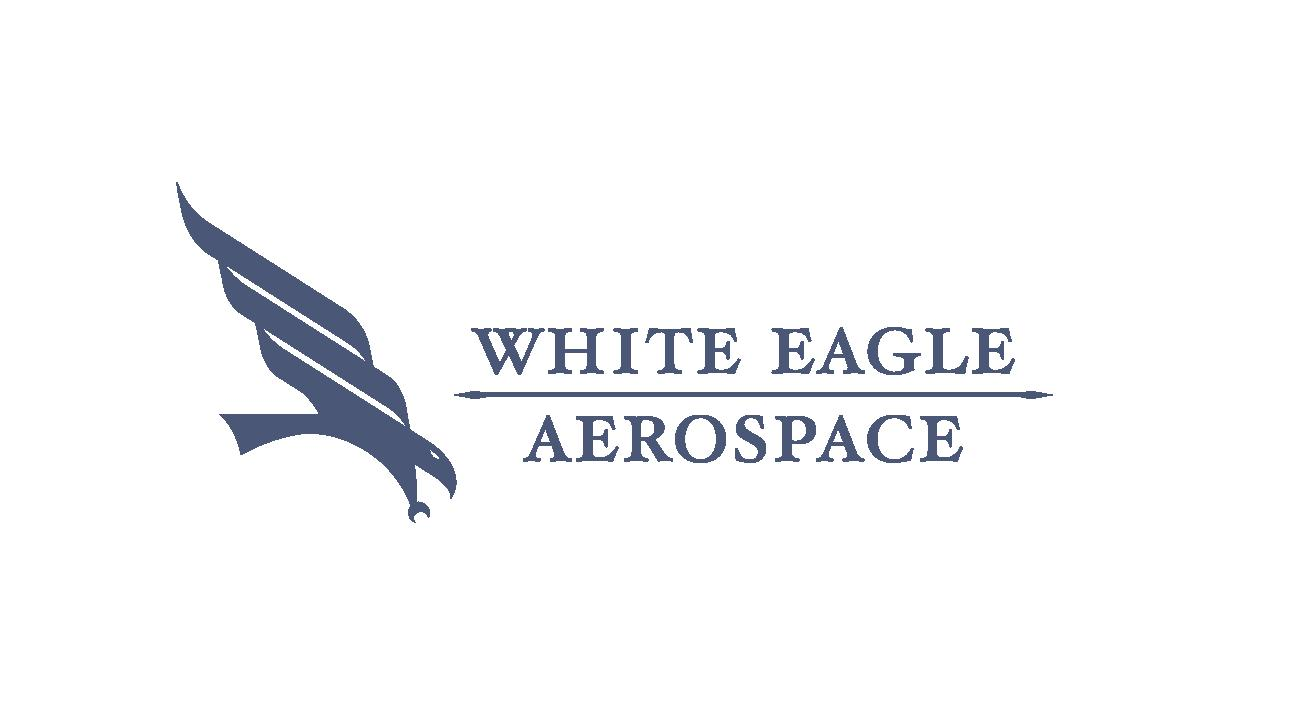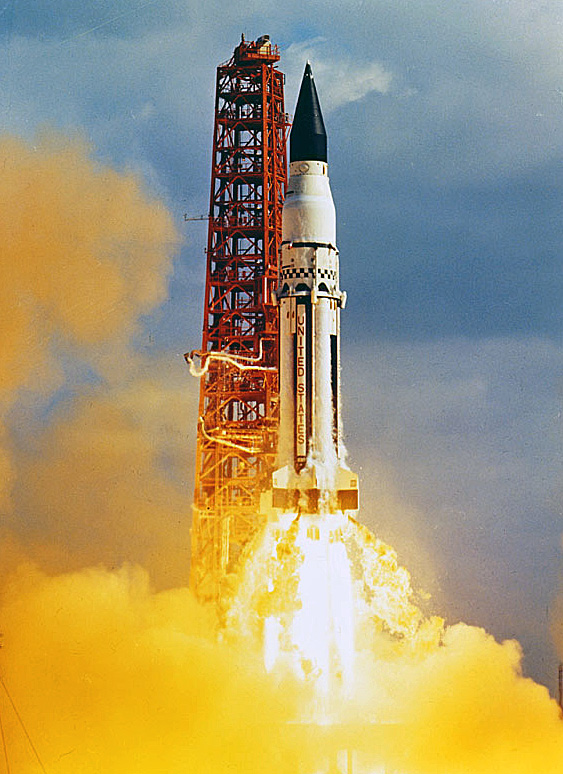
Fifty-years ago this month, NASA successfully launched the first Saturn I Block II heavy-lift launch vehicle. Known as Saturn-Apollo No. 5 (SA-5), the mission featured the largest mass ever orbited up that time in the history of spaceflight.
The Saturn I was a pathfinder rocket booster that ultimately lead to the development of the mighty Saturn V launch vehicle. Ten (10) Saturn I boosters were flown between October 1961 and July 1965. The first four (4) missions involved the Block I variant wherein only the first stage was powered. The final six (6) missions employed Block II vehicles which included live first and second stages.
The Saturn I measured 164 feet in length with a maximum diameter of 21.42 feet. The S-I first stage was powered by an octet of Rocketdyne H-1 engines that generated a total sea level thrust of 1,500,000 lbs. The S-IV seconds stage incorporated six (6) Pratt and Whitney RL10 engines rated at a total vacuum thrust of 900,000 lbs.
SA-5 was launched from LC-37 at Cape Canaveral, Florida on Wednesday, 29 January 1964. Weighing 1,121,680 lbs at first stage ignition, the vehicle lifted-off at 14:25:01 UTC. As the first and second stages functioned in splendid fashion, the second stage successfully achieved an elliptical orbit measuring 142 x 415 nm.
The SA-5 orbited mass of 37,700 lbs was a record for the time. This payload, consisting of the S-IV stage, an instrument unit, and a modified Jupiter nose cone filled with sand ballast, remained in orbit through the end of April 1966.
The SA-5 mission was significant for a variety of reasons. It featured the first live S-IV rocket stage and was the first Saturn I vehicle to achieve orbit. It also marked that moment in spaceflight history when America finally surpassed the Soviet Union in payload mass to orbit capability. Known as “bridging the booster gap”, this event was an important step in the race to the moon in which America would be the ultimate victor.
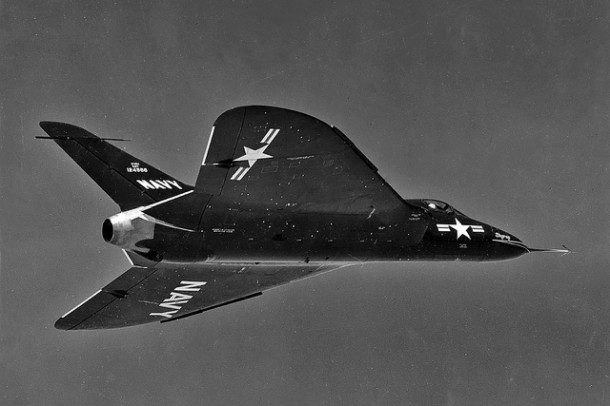
Sixty-three years ago this month, the USN/Douglas XF4D-1 Skyray fighter flew for the first time at Edwards Air Force Base in California. Douglas test pilot Robert O. Rahn was at the controls of the single-engine, carrier-based, supersonic-capable aircraft.
The Douglas XF4D-1 was the prototype version of the United States Navy’s F4D-1 Skyray. Designed to intercept adversary aircraft at 50,000 feet within 300 seconds of take-off, development of the Skyray began in the late 1940’s. As an aside, the Skyray nickname derived from the type’s large delta wing which gave it the appearance of a Manta ray.
The Skyray was originally designed to be powered by a Westinghouse XJ40-WE-6 turbojet capable of 7,000 lbs of sea level thrust. However, when significant developmental problems were encountered with that power plant, Douglas substituted an Allison J35-A-17 turbojet to support early flight testing of the XF4D-1. With a max sea level thrust of 5,000 lbs, the J35 rendered these early airframes significantly underpowered.
A pair of XF4D-1 Skyray airframes were built by Douglas. Ship No. 1 was assigned tail number BuAer 124586 while Ship No. 2 received the designation BuAer 124587.
On Tuesday, 23 January 1953, XF4D-1 Ship No. 1 (BuAer No 124586) departed Edwards Air Force Base on its first foray into the wild blue. Doing the piloting honors on this occasion was highly regarded Douglas test pilot Bob Rahn. The delta-winged beauty performed well on this maiden flight which concluded with Rahn making an uneventful landing back at Edwards.
Extensive flight testing of the Skyray, including carrier trials, continued through 1955. The Westinghouse XJ40-WE-8 appeared on the scene during this time. Rated at 11,600 lbs of sea level thrust in afterburner, this power plant allowed the Skyray to establish several speed records in California during October of 1953. Specifically, a speed of 752.944 mph was registered within a 3-kilometer course over the Salton Sea followed by 100-kilometer closed course mark of 728.11 mph at Edwards AFB.
Unfortunately, the XJ40 would prove to be very temperamental and unreliable. Inflight engine fires, explosions, and component failures constantly plagued the Skyray program. Westinghouse never did solve these problems to the satisfaction of the Navy. As a result, the service eventually opted to power production aircraft with the Pratt and Whitney J57-P-8 turbojet (10,200 lbs of sea level thrust).
The Douglas F4D-1 Skyray went on to serve with the United States Navy and Marines from 1956 through 1964. A total of 420 aircraft were produced. While never used in anger, the Skyray was a solid performer and served well in its intended role as a point design interceptor.
The Skyray holds the distinction of being the last fighter produced by the Douglas Aircraft Company before this legendary aerospace giant merged with McDonnell Aircraft to form McDonnell Douglas.
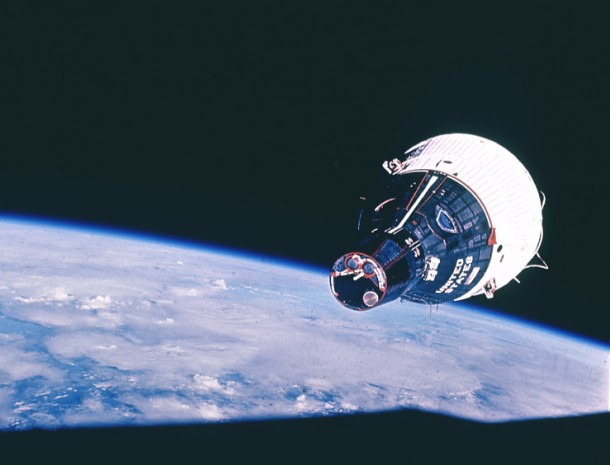
Forty-eight years ago this month, Gemini 7 set a new record for long-duration manned spaceflight. The official lift-off-to-splashdown flight duration was 330 hours, 35 minutes and 1 second.
Project Gemini was the critical bridge between America’s fledgling manned spaceflight effort – Project Mercury – and the bold push to land men on the Moon – Project Apollo. While the events and importance of this program have faded somewhat with the passage of time, there would have been no manned lunar landing in the decade of the 1960′s without Project Gemini.
On Thursday, 25 May 1961, President John F. Kennedy addressed a special session of the U.S. Congress on the topic of ”Urgent National Needs”. Near the end of his prepared remarks, President Kennedy proposed that the United States “should commit itself to achieving the goal, before this decade is out, of landing a man on the moon and returning him safely to the earth.”
At the time of the President’s clarion call to go to the Moon, the United States had accrued a total of 15 minutes of manned spaceflight experience. That quarter hour of space faring activity had come just 20 days previous. Indeed, Alan B. Shepard became the first American to be launched into space when he rode his Freedom 7 Mercury spacecraft on a sub-orbital trajectory down the Eastern Test Range on Tuesday, 05 May 1961.
America responded enthusiastically to the manned lunar landing goal. However, no one really knew exactly how to go about it! After considering several versions of direct ascent from the Earth to the Moon, NASA ultimately decided to use a method proposed by engineer John C. Houbolt known as Lunar Orbit Rendezvous (LOR). As a result, NASA would have to invent and master the techniques of orbital rendezvous.
Project Gemini provided the technology and flight experience required for a manned lunar landing and return. In the 20 months between March of 1965 and November of 1966, a total of 10 two-man Gemini missions were flown. During that time, the United States learned to navigate, rendezvous and dock in space, fly for long durations and perform extra-vehicular activities.
The primary purpose of Gemini 7 was to conduct a 14-day orbital mission. This was important since the longest anticipated Apollo mission to the Moon and back would be about the same length of time. Gemini 7 was flown to show that men and spacecraft could indeed function in space for the required period. A secondary goal of Gemini 7 was to serve as the target for Gemini 6 in achieving the world’s first rendezvous between two manned spacecraft.
Gemini-Titan (GT-7) lifted-off from Cape Canaveral’s LC-19 at 19:30:03 UTC on Saturday, 04 December 1965. The Gemini 7 flight crew consisted of Commander Frank F. Borman II and Pilot James A. Lovell, Jr. They were successfully inserted into a 177-nm x 87-nm low-earth orbit. This initial orbit was later circularized to 162-nm.
Borman and Lovell spent the first 10-days of their mission conducting a variety of space experiments. They wore special lightweight spacesuits that were supposed to improve comfort level for their long stay in space. However, these suits were not all that comfortable and by their second week in space, the astronauts were flying in just their long-johns.
On their 11th day in space, the Gemini 7 crew had visitors. Indeed, Gemini 6 was launched into Earth orbit from Cape Canaveral and subsequently executed the first rendezvous in space with Gemini 7 on Wednesday, 15 December 1965. Gemini 6, with Commander Walter M. Schirra, Jr. and Pilot Thomas P. Stafford on board, ultimately maneuvered to within 1 foot of the Gemini 7 spacecraft.
While Gemini 6 returned to Earth within 24 hours of launch, Gemini 7 and her weary crew soldiered on. The monotony was brutal. Borman and Lovell had conducted all of their planned space experiments. They had to drift through space to conserve fuel. They couldn’t sleep because they weren’t tired. Borman later indicated that those last 3 days on board Gemini 7 were some of the toughest of his life.
On the 14th day of flight, Saturday, 18 December 1965, Borman and Lovell successfully returned to Earth. Reentry was entirely nominal. Splashdown occurred at 14:05:04 UTC in the Atlantic Ocean roughly 400 miles east of Nassau in The Bahamas. Crew and spacecraft were recovered by the USS Wasp.
Frank Borman and Jim Lovell had orbited the Earth 206 times during their 14-day mission. Each crew member was tired and a little unsteady as he walked the flight deck of the USS Wasp. However, each man quickly recovered his native strength and vitality.
The 14 days that the Gemini 7 crew spent in space were physically and emotionally demanding. Life within the cramped confines of their little spacecraft was akin to two guys living inside a telephone booth for two weeks. Notwithstanding the challenges of that spartan existence, the Gemini 7 crew did their job. Gemini 7 was a resounding success. More, Project Gemini had achieved another key milestone. The Moon seemed a bit closer.
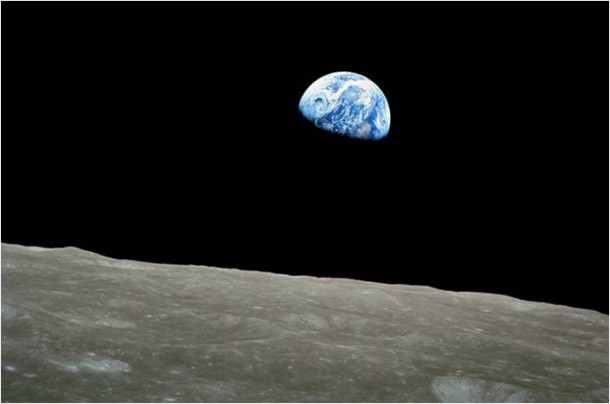
Forty-five years ago this month, three American astronauts became the first men to orbit the Earth’s Moon during the flight of Apollo 8. The flight also marked the first manned flight of the mighty Saturn V launch vehicle as well as history’s first super-orbital entry of a manned spacecraft.
Following the Apollo 1 tragedy in January of 1967, the United States would not fly another manned space mission until October 1968. That flight, Apollo 7, was a highly successful earth-orbital mission in which the new Block II Apollo Command Module was thoroughly flight-proven.
Notwithstanding Apollo 7 ‘s accomplishments, only 14 months remained for the United States to meet the national goal of achieving a manned lunar landing before the end of the 20th century’s 7th decade. The view held by many in late 1968 was that an already daunting task was now unachievable in the narrow window of time that remained to accomplish it.
The pessimism about reaching the Moon before the end of the decade was easy to understand. The Saturn V moon rocket had not been man-rated. The Lunar Module had not flown. Lunar Orbit Rendezvous (LOR) was untried. Men had not even so much as orbited the Moon. Yet, history would record that the United States would find a way to accomplish that which had never before been achieved.
George Low, manager of NASA’s Apollo Spacecraft Program Office, came up with the idea. Low proposed that the first manned flight of the Saturn V be a trip all the way to the Moon. It was something that Low referred to as the “All-Up Testing” concept. The newly-conceived mission would be flown in December 1968 near Christmas time.
While initially seen as too soon and too risky by many in NASA’s management hierarchy, Low’s bold proposal was ultimately accepted as the only way to meet the national lunar landing goal. Yes, there was additional risk. However, the key technologies were ready, the astronauts were willing, and the risk was tolerable.
Apollo 8 lifted-off from LC-39A at the Kennedy Space Center in Florida on Saturday, 21 December 1968 at 12:51 hours UTC. The crew consisted of NASA astronauts Frank Borman, James A. Lovell, Jr. and William A. Anders. Their target – the Moon – was 220,000 miles away.
After a 69-hour outbound journey, Apollo 8 entered lunar orbit on Tuesday, 24 December 1968 – Christmas Eve. The Apollo 8 crew photographed the lunar surface, studied the geologic features of its terrain, and made other observations from a 60-nautical mile circular orbit. The spacecraft circled the Moon 10 times in slightly over 20 hours.
The most poignant and memorable event in Apollo 8′s historic journey occurred on Christmas Eve night when each of the flight crew took turns reading from the Book of Genesis in the Holy Bible. The solemnity of the moment was evident in the voices of the astronauts. They had seen both the Moon and the Earth from a perspective that none before them had. Fittingly, they expressed humble reverence for the Creator of the Universe on the anniversary of the birth of mankind’s Redeemer.
Apollo 8 departed lunar orbit a little over 89 hours into the mission. Following a nearly 58-hour inbound trip, Apollo 8 reentered the earth’s atmosphere at 36, 221 feet per second on Friday, 27 December 1968. The first manned superorbital reentry was performed in total darkness. It was entirely successful as Apollo 8 landed less than 1 nautical mile from its target in the Pacific Ocean. The USS YORKTOWN effected recovery of the weary astronauts and their trustworthy spacecraft. Mission total elapsed time was 147 hours and 42 seconds.
The year 1968 was a tumultuous one for the United States of America. Martin Luther King and Robert Kennedy had been assassinated. American military blood flowed on the battlefields of Vietnam and civilian blood was let in countless demonstrations taking place in the nation’s cities. The ill-posed sexual revolution continued to eat away at the country’s moral moorings.
But, as is so often the case, an event from the realm of flight, now newly extended to lunar space, reminded us of our higher nature and potential. For a too brief moment, Apollo 8 put our collective purpose for being here into sharp focus. Perhaps a short phrase in a telegram sent to Frank Borman from someone he had never met said it best: “You saved 1968!”
However, looking through the lens of history, we now know that Apollo 8 did much more than end the penultimate year of the 1960′s on a positive note. Indeed, Apollo 8 saved the entire Apollo Program.
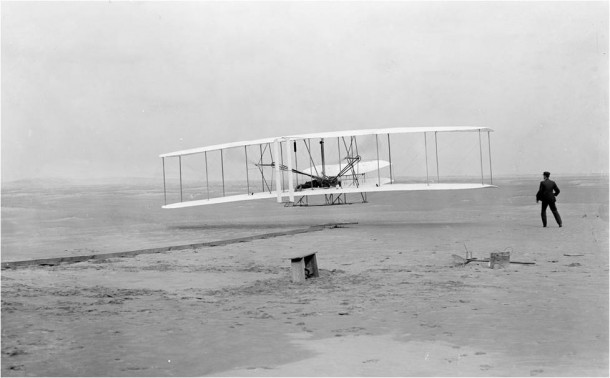
One-hundred and ten years ago today, the Wright Flyer became the first aircraft in history to achieve powered flight. The site of this historic event was Kill Devil Hills near Kitty Hawk, North Carolina.
Americans Wilbur and Orville Wright began their legendary aeronautical careers in 1899. In just four short years, the brothers would go from complete aeronautical novices to inventors and pilots of the world’s first successful powered aircraft. Interestingly, neither man attended college nor received even a high school diploma.
The Wright Flyer measured roughly 21 feet in length and had a wing span of approximately 40 feet. The biplane aircraft had an empty weight of 605 lbs. Power was provided by a single 12 horsepower, 4-cylinder engine that drove twin 8.5 foot , two-blade propellers.
The Flyer made a powered take-off run along a 60-foot wooden guide rail. The aircraft was mounted on a two-wheel dolly that rode along the track and was jettisoned at lift-off. The Flyer pilot lay prone in the middle of the lower wing. Twin elevator and rudder surfaces provided aircraft pitch and yaw control, respectively. Roll control was via differential wing warping.
The Wright Brothers had come close to achieving a successful powered flight with the Wright Flyer on Monday, 14 December 1903. Wilbur, by virtue of winning the coin toss, was the pilot for this initial attempt. However, the Flyer stalled and hit the ground sharply just after take-off. Wilbur was unhurt, but repair of the damaged aircraft would require two days to complete.
The next attempt flight took place on Thursday, 17 December 1903. The weather was terrible. Windy and rainy. Even after the rain abated, the wind continued to blow in excess of 20 mph. The Wrights decided to fly anyway. It was now Orville’s turn as command pilot.
Orville took his position on the Flyer and was quickly launched into the wind. Once airborne, the aircraft proved difficult to control as it porpoised up and down along the flight path. Nonetheless, Orville kept the Flyer in the air for 12 seconds before landing 120 feet from the take-off point. Other than a damaged skid, the aircraft was intact and the pilot unhurt. Powered flight was a reality!
Three more flights followed on that momentous occasion as the brothers alternated piloting assignments. The fourth flight was the longest in both time aloft and distance flown. With Wilbur at the controls, the Wright Flyer flew for 59 seconds and landed 852 feet from the take-off point.
The Wright Brothers father, Milton, would soon learn of the epic events that December day in North Carolina. Orville’s verbatim Western Union telegram message sent to Dayton, Ohio read:
Success four flights thursday morning all against twenty one mile wind started from Level with engine power alone average speed through air thirty one miles longest 57 [sic] seconds inform Press home Christmas.
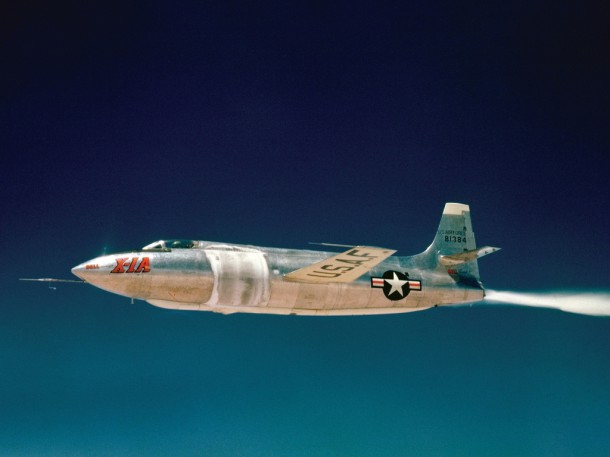
Sixty years ago this week, USAF Major Charles E. Yeager set an unofficial world speed record of 1,650 mph (Mach 2.44) in the Bell X-1A flight research aircraft. In the process, Yeager nearly lost his life.
The USAF/Bell X-1A was a second generation X-aircraft intended to explore flight beyond Mach 2. It measured 35.5 feet in length and had a wing span of 28 feet. Gross take-off weight was 16,500 pounds.
Like its XS-1 forebear, the X-1A was powered by an XLR-11 rocket motor which produced a maximum sea level thrust of 6,000 lbs. The XLR-11 burned 9,200 pounds of propellants (alcohol and liquid oxygen) in roughly 270 seconds of operation.
Departing Edwards Air Force Base, California on Saturday, 12 December 1953, Yeager and the X-1A (S/N 48-1384) were carried to altitude by a USAF B-29 mothership (S/N 45-21800 ). X-1A drop occurred at 240 knots and 30,500 feet. Within ten seconds, Yeager lit off three of the XLR-11′s four rocket chambers and started to climb upstairs.
Yeager fired the 4th chamber of the XLR-11 passing through 43,000 feet and initiated a pushover at 62,000 feet. The maneuver was completed at 76,000 feet; higher than planned. In level flight now and traveling at Mach 1.9, the X-1A continued to accelerate in the thin air of the stratosphere.
Yeager quickly exceeded Scott Crossfield’s briefly-held Mach 2.005 record set on Friday, 20 November 1953. However, he now had to be very careful. Wind tunnel testing had revealed that the X-1A would be neutrally stable in the directional channel as it approached Mach 2.3.
As Yeager cut the throttle around Mach 2.44, the X-1A started an uncommanded roll to the left. Yeager quickly countered with aileron and rudder. The X-1A then rapidly rolled right. Full aileron and opposite rudder failed to control the roll. After 8 to 10 complete revolutions, the aircraft ceased rolling, but was now inverted.
In an instant, the X-1A started rolling left and then went divergent in all three axes. The aircraft tumbled and gyrated through the sky. Control inputs had no effect. Yeager was in serious trouble. He could not control his aircraft and punching-out was not an option. The X-1A had no ejection seat.
Chuck Yeager took a tremendous physical and emotional beating for more than 70 seconds as the X-1A wildly tumbled. Normal acceleration varied between plus-8 and negative 1.3 G’s. His helmet hit the canopy and cracked it. He struck the control column so hard that it was physically bent. His frantic air-to-ground communications were distinctly those of a man who was convinced that he was about to die.
As the X-1A tumbled, it decelerated and lost altitude. At 33,000 feet, a battered and groggy Yeager found himself in an inverted spin. The aircraft suddenly fell into a normal spin from which Yeager recovered at 25,000 feet over the Tehachapi Mountains situated northwest of Edwards. Somehow, Yeager managed to get himself and the X-1A back home intact.
The culprit in Yeager’s wide ride was the then little-known phenomenon identified as roll inertial coupling. That is, inertial moments produced by gyroscopic and centripetal accelerations overwhelmed aerodynamic control moments and thus caused the aircraft to depart controlled flight. Roll rate was the critical mechanism since it coupled pitch and yaw motion.
The X-1A held the distinction of being the fastest-flying of the early X-aircraft until the Bell X-2 reached 1,900 mph (Mach 2.87) in July of 1956. Yeager’s harrowing experience in December 1953 would be his last flight at the controls of a rocket-powered X-aircraft. For his record-setting X-1A mission, he was awarded the 1953 Harmon Trophy.
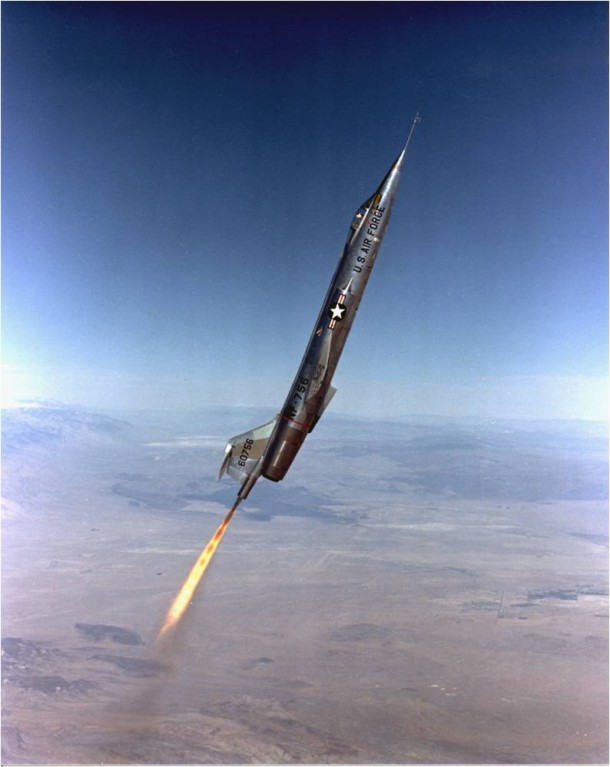
Fifty years ago this week, USAF Major Robert W. Smith zoomed the rocket-powered Lockheed NF-104A to an unofficial record altitude of 120,800 feet. This mark still stands as the highest altitude ever achieved from a runway take-off by a United States aircraft.
A zoom maneuver is one in which aircraft kinetic energy (speed) is traded for potential energy (altitude). In doing so, an aircraft can soar well beyond its maximum steady, level altitude (service ceiling). The zoom maneuver has both military and civilian flight operations value.
The USAF/Lockheed NF-104A was designed to provide spaceflight-like training experience for test pilots attending the Aerospace Research Pilot School (ARPS) at Edwards Air Force Base, California. The type was a modification of the basic F-104A aircraft. Three copies of the NF-104A were produced (S/N’s 56-0756, 56-0760 and 56-0762). It was the ultimate zoom flight platform.
In addition to a stock General Electric J79-GE-3 turbojet, the NF-104A was powered by a Rocketdyne LR121-NA-1 rocket motor. The J79 generated 15,000 pounds of thrust in afterburner and burned JP-4. The LR-121 produced 6,000 pounds of thrust and burned a combination of JP-4 and 90% hydrogen peroxide. Rocket motor burn time was on the order of 90 seconds.
The NF-104A was kinematically capable of zooming to altitudes approaching 125,000 feet. As such, it was a combined aircraft and spacecraft. The pilot had to blend aerodynamic and reaction controls in the low dynamic pressure environment near the zoom apex. He was also required to fly in a full pressure suit for survival at altitudes beyond the Armstrong Line.
On Friday, 06 December 1963, Bob Smith took-off from Edwards and headed west for the Pacific Ocean. Out over the sea, he changed heading by 180 degrees in preparation for the zoom run-in. At a point roughly 100 miles out, Smith then accelerated the NF-104A (S/N 56-0760) along a line that would take him just north of the base. Arriving at Mach 2.4 and 37,000 feet, Smith then initiated a 3.75-g pull to a 70-degree aircraft pitch angle. Turbojet and rocket were at full throttle.
Things happened very quickly now. Smith brought the turbojet out of afterburner at 65,000 feet and then moved the throttle to the idle detent at 80,000 feet. The rocket motor burned-out around 90,000 feet. Smith controlled the aircraft (now spacecraft) over the top of the zoom using 3-axis reaction controls. The NF-104A’s arcing parabolic trajectory subjected him to 73 seconds of weightlessness. Peak altitude achieved was 120,800 feet above mean sea level.
On the back side of the zoom profile, Bob Smith restarted the windmilling J79 turbojet and set-up for landing at Edwards. He touched down on the main runway and rolled out uneventfully. Total mission time from brake-release to wheels-stop was approximately 25 minutes.
Much more could be said about the NF-104A and its unique mission. Suffice it to say here that two of the aircraft ultimately went on to serve in the ARPS from 1968 to 1971. The only remaining aircraft today is 56-0760 which sits on a pole in front of the USAF Test Pilot School at Edwards.
Bob Smith went on to make many other noteworthy contributions to aviation and his nation. Having flown the F-86 Sabre in Korea, he volunteered to fly combat in Viet Nam in his 40th year. Stationed at Korat AFB in Thailand, he commanded the 34th Fighter Squadron of the 388th Tactical Fighter Wing. Smith flew 100 combat missions in the F-105; many of which involved the infamous Pack VI route in North Viet Nam.
Bob Smith is a true American hero. Like so many of the valiant airmen of his day, Smith is a man whose dedication, service, and courage went largely unnoticed and unappreciated by many of his fellow countrymen. However, for those who know the true character and heart of Bob Smith and those of his ilk, we offer this sincere, but clearly inadequate sentiment: Thank You.
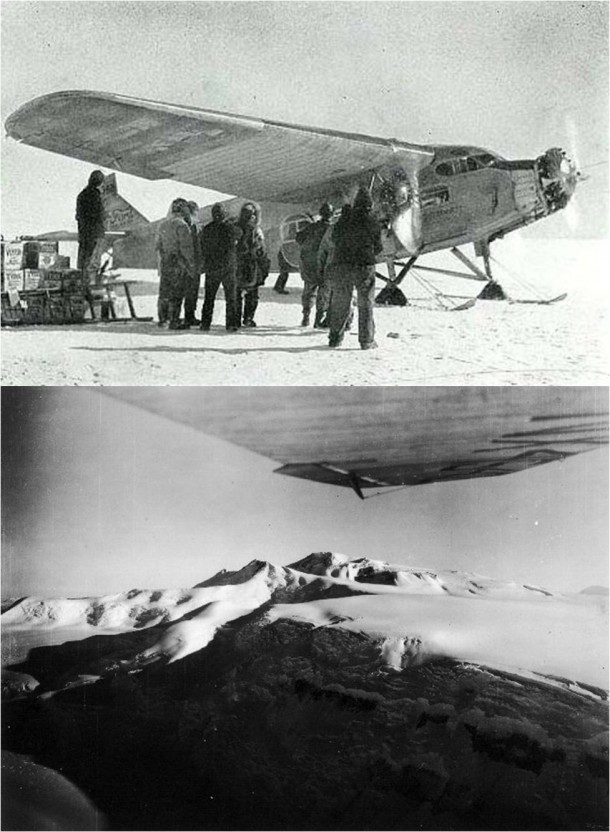
Eighty-four years ago this week, a four-man crew became the first Antarctic explorers to fly over the Earth’s South Pole. The aircraft used to make the historic flight was a Ford Trimotor.
While substantial exploration of the Artic and Antarctic by land and sea had occurred far earlier, exploration of these regions by air was in its infancy during the decade of the 1920′s. Of particular focus was the goal to fly over both the North and South Poles.
The historic first flight to the South Pole originated from Little America, an exploration base camp situated on Antartica’s Ross Ice Shelf. Distance to the South Pole was about 800 miles as the crow flies.
A Ford Trimotor aircraft, the Floyd Bennett (S/N NX4542), was selected for the epic polar air journey. The crew consisted of pilot Bernt Balchen, co-pilot Harold June, navigator Richard E. Byrd, and radio operator Ashley McKinley.
The fabled Trimotor was well-suited for the rigors of polar flight. The all-metal aircraft measured 50-feet in length and had a wing span of 76-feet. Empty weight was roughly 6,500 pounds. Power was provided by a single 520-HP Wright Cylone and a pair of 200-HP Wright Whirlwind radial engines.
Following departure from Little America at 02:39 UTC, the Floyd Bennettheaded for the South Pole. Navigation was via sun compass due to the proximity of the South Magnetic Pole.
Myriad glaciers, massifs, plateaus, and crevasses marked the stark, rugged landscape unfolding under the Floyd Bennett’s flight path. The most imposing of these geological features were the Queen Maud Mountains that towered more than 11,000 feet above sea level.
Pilot Balchen struggled to get his aircraft over the high mountain pass that runs between Mounts Fridtjof and Fisher. The crew jettisoned empty fuel cans and hundreds of pounds of precious food to lighten the load. The Floyd Bennett cleared the terrain by about 600 feet.
Just after 1200 UTC (local midnight) on Friday, 29 November 1929, theFloyd Bennett and her crew flew over the Earth’s South Pole. After briefly loitering around the Pole, the aircraft headed back to Little America at 1225 UTC.
According to plan, Balchen landed the airplane to take on 200 gallons of fuel that had been pre-positioned at the base of the Liv Glacier. TheFloyd Bennett took-off again and landed back at Little America around 21:10 UTC. Total mission time was nearly 19 hours.
United States Navy Commander Richard E. Byrd now had flown over both poles. He would go on to successfully explore the Antarctic for many more years. For his part in the South Pole overflight, Byrd was promoted to the rank of Rear Admiral.
Today, the aircraft that made the first flight over the South Pole in November 1929 is displayed in the Heroes of the Sky exhibit at the Henry Ford Museum in Dearborn, Michigan.fixed-wing aircraft ever operated by the United States Navy.
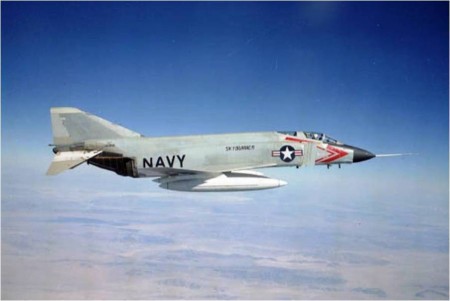
Fifty-two years ago this month, a United States Navy YF4H-1 Phantom II set a world absolute speed record of 1,606.342 mph. Piloting the aircraft for this record flight was United States Marine Corps Lieutenant Colonel Robert B. Robinson.
The McDonnell Douglas YF4H-1 Phantom II was first flown in May 1958. The aircraft measured 58 feet length with a wing span of 38 feet. Gross take-off weight was 44,000 pounds. A pair of General Electric J79-GE-8 turbojets produced a total of 34,000 pounds of thrust in afterburner.
The YF4H-1 was the first in a long line of Phantom II variants that would eventually see a production run of 5,195 aircraft. Second only to the nearly 10,000 production units of the multi-variant North American F-86 Sabre.
Since 1961 marked the 50th anniversary of Naval Aviation, the US Navy planned to celebrate by establishing a series of speed records. The aircraft of choice was their super-powered Phantom II. Operation SAGEBURNER was the low altitude speed program (i.e., 125 feet off the deck) while Operation SKYBURNER was the high altitude speed component.
On Wednesday, 22 November 1961, the second YF4H-1 (S/N 142260) took-off from Edwards Air Force Base, California in an attempt to surpass the existing world absolute speed record. A United States Air Force F-106 Delta Dart, piloted by Major Joseph W. Rogers, held the existing record of 1,525.96 mph which was set on Tuesday, 15 December 1959.
Robinson had to fly a precisely-timed and positioned flight profile to extract maximum performance from his YF4H-1. FAI rules required the aircraft to enter the Edwards speed course in level flight and to make two runs. The final speed mark would be the average of the two runs.
The Phantom II was a big airplane and had to carry a lot of fuel. In addition to a full internal fuel load, the aircraft carried a 600-gallon centerline tank and a pair of 370-gallon wing tanks. Following take-off to the east, climb-out was made to the south toward El Centro, California. Arriving in the area, Robinson made a sweeping left-hand turn over the Salton Sea and accelerated the aircraft north back towards Edwards.
As the aircraft gained speed, Robinson dropped the empty centerline fuel tank over the Chocolate Mountains gunnery range. Then, arriving over the Bristol Dry Lake range, he punched-off the empty wing tanks. The aircraft was now lighter and aerodynamically cleaner.
Robinson approached the Edwards speed course from the east in full afterburner. The Phantom II exited the 20-mile course quickly. Following his first pass, Robinson came out of afterburner, made a Mach 0.9 turn to the south, cruised 105 miles out and then made the turn back to Edwards for the second speed pass.
His aircraft lighter now and not having to concern himself with the logistics of dropping empty fuel tanks, Robinson was clocked at over 1,700 mph on his second time through the Edwards speed course. The two-run average was 1,606.342 mph; a new world absolute speed record.
The F-4 Phantom II would go on to a legendary combat career in both the United States Navy and United States Air Force. Among many distinctions, the McDonnel Douglas F-4 Phantom II is the only aircraft to have seen service with both the USAF Thunderbirds (1969-1973) and the US Navy Blue Angels (1969-1974) flight demonstration squadrons.
For setting the world absolute speed record in 1961, Operation SKYBURNER pilot Bob Robinson was presented with the Distinguished Flying Cross by the then-Secretary of the Navy, John B. Connally.
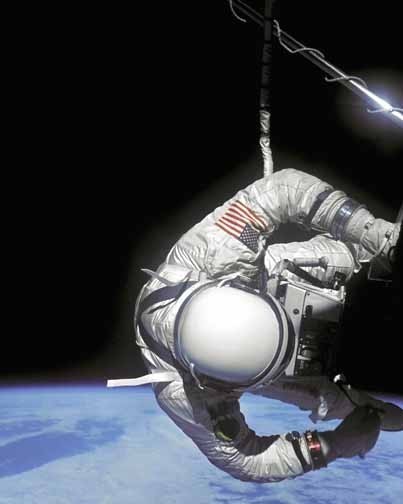
Forty-seven years ago this month, NASA’s pioneering spaceflight program, Project Gemini, was brought to a successful conclusion with the 4-day flight of Gemini XII. Remarkably, the mission was the tenth Gemini flight in 20 months.
Boosted to Earth orbit by a two-stage Titan II launch vehicle, Gemini XII Command Pilot James A. Lovell, Jr. and Pilot Edwin E. “Buzz” Aldrin, Jr. lifted-off from Cape Canaveral’s LC-19 at 20:46:33 UTC on Friday, 11 November 1966. The flight was Lovell’s second trip into space and Aldrin’s first.
Like almost every Gemini mission before it, Gemini XII was not a glitch-free spaceflight. For instance, when the spacecraft’s rendezvous radar began acting oddly, the crew had to resort to sextant and chart to complete the last 65 nautical miles of the rendezvous with their Agena Target Vehicle. But, overcoming this and other obstacles served to provide the experience and instill the confidence needed to meet the truly daunting challenge that lay ahead; landing on the Moon.
Unquestionably, Gemini XII’s single most important contribution to the United States manned space effort was validating the notion that a well-trained astronaut could indeed do useful work in an Extra-Vehicular Activity (EVA) environment. The exhausting and even dangerous EVA experiences of Gene Cernan on Gemini IX and Dick Gordon on Gemini XI brought into sharp focus the challenge of performing even seemingly simple work assignments outside the Gemini spacecraft.
Buzz Aldrin performed a trio of EVA’s on Gemini XII. Two of these involved standing in his seat with the hatch open. The third involved a tethered EVA or space walk. On the latter, Aldrin successfully moved about the exterior of the Gemini-Agena combination without exhausting himself. He also used a special-purpose torque wrench to perform a number of important work tasks. Central to Aldrin’s success was the use of foot restraints and auxiliary tethers to anchor his body while floating in a weightless state.
Where others had struggled and not been able to accomplish mission EVA goals, Buzz Aldrin came off conqueror. One of the chief reasons for his success was effective pre-flight training. A pivotal aspect of this training was to practice EVA tasks underwater as a unique means of simulating the effects of weightlessness. This approach was found to be so useful that it has been used ever since to train American EVA astronauts.
Lovell and Aldrin did many more things during their highly-compressed 4-day spaceflight in November of 1966. Multiple dockings with the Agena, Gemini spacecraft maneuvering, tethered stationkeeping exercises, fourteen scientific experiments, and photographing a total eclipse occupied their time aloft.
On Tuesday, 15 November 1966, on their 59th orbit, a tired, but triumphant Gemini XII crew returned to Earth. The associated reentry flight profile was automated; that is, totally controlled by computer. Yet another first and vital accomplishment for Project Gemini. Splashdown was in the West Atlantic at 19:21:04 UTC.
While Gemini would fly no more, both Lovell and Aldrin certainly would. In fact, both men would play prominent roles in several historic flights to the Moon. Jim Lovell flew on Apollo 8 in December 1968 and Apollo 13 in April 1970. And of course, Buzz Aldrin would walk on the Moon at Mare Tranquilitatis in July 1969 as the Lunar Module Pilot for Apollo 11.











